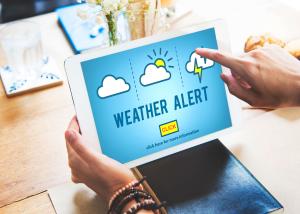
Spring can be a mixed bag in the Midwest. Fluctuating temperatures and unpredictable weather patterns can leave homeowners guessing. It’s not uncommon to have snow in April on one day and then 70-degree weather on the next.
That’s why it’s important for homeowners to have emergency preparedness plans and knowledge if and when a disaster strikes. A checklist can be a great resource to help you protect your loved ones in a moment of crisis. Here’s what you need to know about weather-related safety at home.
Stay Informed
There’s no substitute for being vigilant. Keep an eye on the weather forecast and watch for any alerts from the government. Authorities will issue statements about the conditions and risks that can better inform your action.
Regardless, keeping a battery-powered radio on hand is a good idea. This way if the power goes out, you can still have a way to get updates. Weather apps can serve the same purpose.
Prepare Your Home
Checking your home’s condition can also offer peace of mind. Start by inspecting your roof to survey any damage that could allow water in. If you notice any damage, call in the experts as soon as possible.
On a related note, it’s a good idea to be familiar with your homeowners insurance policy before filing a claim. This way you can ensure you’re adequately covered for storm damage, including wind, hail, and flooding. Consider adding additional coverage if necessary. Your agent can educate you on the extent of your coverage and help you determine if you might need a more exhaustive policy or rider.
Next, make sure your gutters and downspouts are clear of debris so they can function properly. This will help prevent water damage and flooding. If you live in an area prone to flooding, consider installing flood barriers to help mitigate a potential issue.
This is also the season to trim any trees or branches close to your home. These can pose a threat to your home or the neighbors’ property during high winds or storms. Remove them before you have a larger problem on your hands. If you don’t have the tools or know-how, call a tree service for help.
Trees aren’t the only concern in your backyard, however. Strong winds can send patio furniture, grills, and trash cans flying and potentially harm people and/or your house. For this reason, make sure these items are securely stored or anchored before the worst of the extreme weather arrives.
And if the weather develops into something severe, you might worry about losing power for days. Purchasing a backup generator can be a worthy investment in the Midwest. Different types of generators meet different needs. For instance, portable generators are hooked up and turned on only as necessary. An automatic standby generator is triggered almost immediately after the power goes out. Both types will work for residential homes. Regardless of choice, be sure to follow the manufacturer’s instructions.
Finally, on the theme of preparing, make sure you have an emergency kit assembled and you can easily access it. It should contain essential supplies such as food, water, first aid supplies, and a flashlight. This will help you and your family stay safe and healthy when Mother Nature is unpredictable. The American Red Cross is a great resource to consult on this matter.
Be Smart About Thunderstorms
Thunderstorms, through a common spring occurrence, pose a severe threat to your safety. Here are a few things you can do to reduce the chance of injury or death due to inclement weather.
- Stay away from windows and doors. This will help protect you from flying debris in case of high winds.
- Avoid using appliances such as computers and televisions, as lightning can cause power surges that can damage these devices.
- Avoid using water or plumbing, which can conduct electricity and pose a risk of electrocution.
Don’t Underestimate Tornadoes
Tornadoes can be dangerous and often strike when you least expect them. Here’s what the experts say you should do when the threat is imminent:
- If you’re inside, go to the lowest level of your home, such as a basement or storm cellar. If this isn’t an option, go to an interior room on the lowest level of your home, such as a bathroom or closet.
- Stay away from windows and doors and cover yourself with a blanket or mattress, in case there’s any debris flying.
Dealing with a Power Loss
If you lose power and don’t have a generator, first don’t panic. Remember that it’s best to avoid opening refrigerators and freezers more often than absolutely necessary. A closed refrigerator will remain cold for up to 12 hours. Kept closed, a well-filled freezer will preserve food for two days.
On the topic of food, a storm isn’t the time to cook. Never use a gas range for heating, or charcoal as an indoor heating or cooking source during a power outage. Instead, turn off or unplug all appliances to prevent an electrical overload when power is restored. This is the time to rely on nonperishable foods or items that don’t require preparation.
After the Storm: Proceed with Caution
You might want to get back to your activities right away but this isn’t advised. It’s best to stay inside at least 30 minutes after you last hear thunder to be sure the storm has passed. And if you must leave your house in the wake of a storm, watch the news for any indication of floods before you head out. The same goes for downed power lines, fallen branches, and other potentially dangerous debris.
For good measure, a qualified electrician can inspect your infrastructure for any issues and ease anxiety. At JO Mory, we take pride in serving customers in Northern Indiana, the Tri-State area, and beyond. If you have questions or would like to arrange for a free quote, please use this form or give us a call: 800.621.6679.